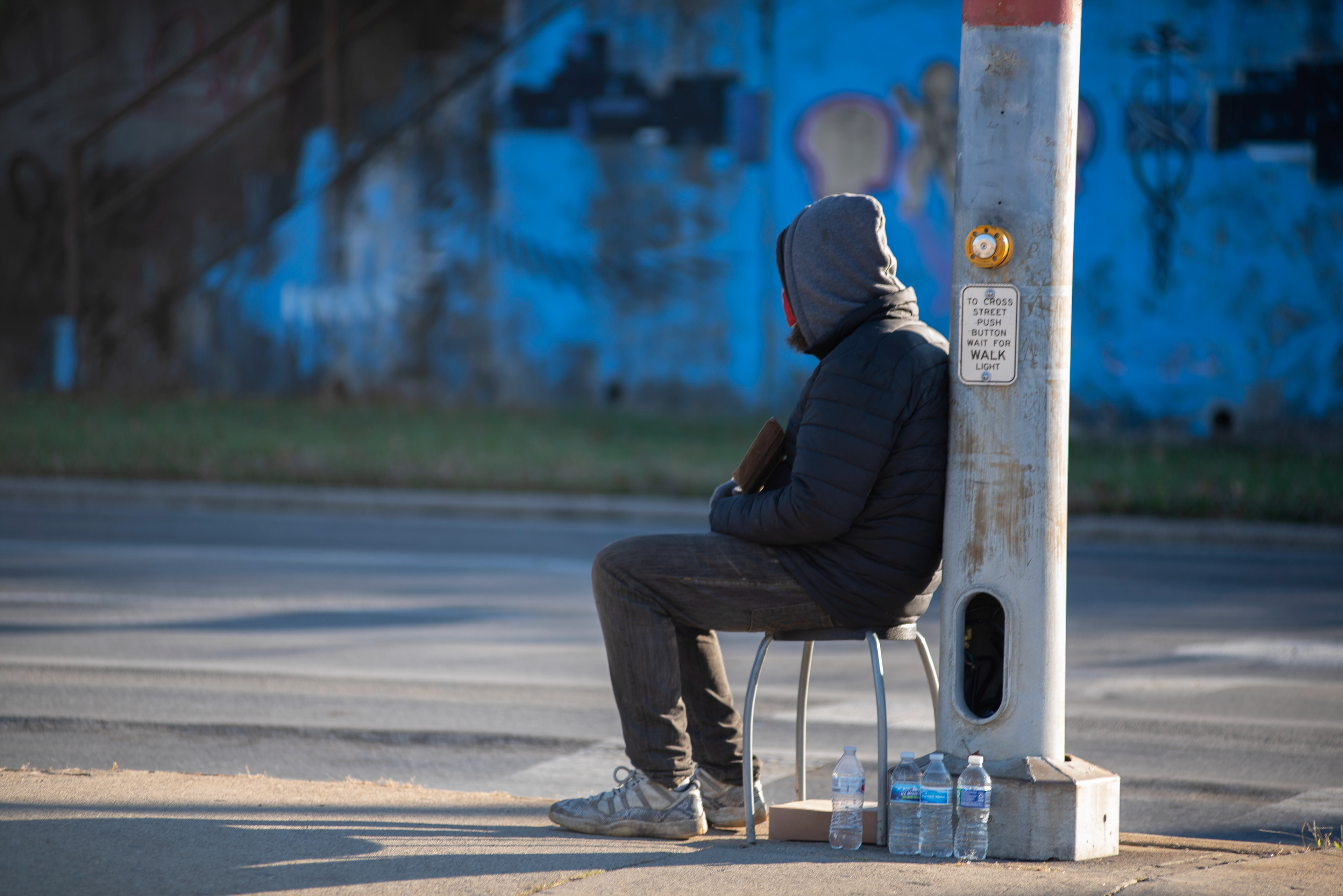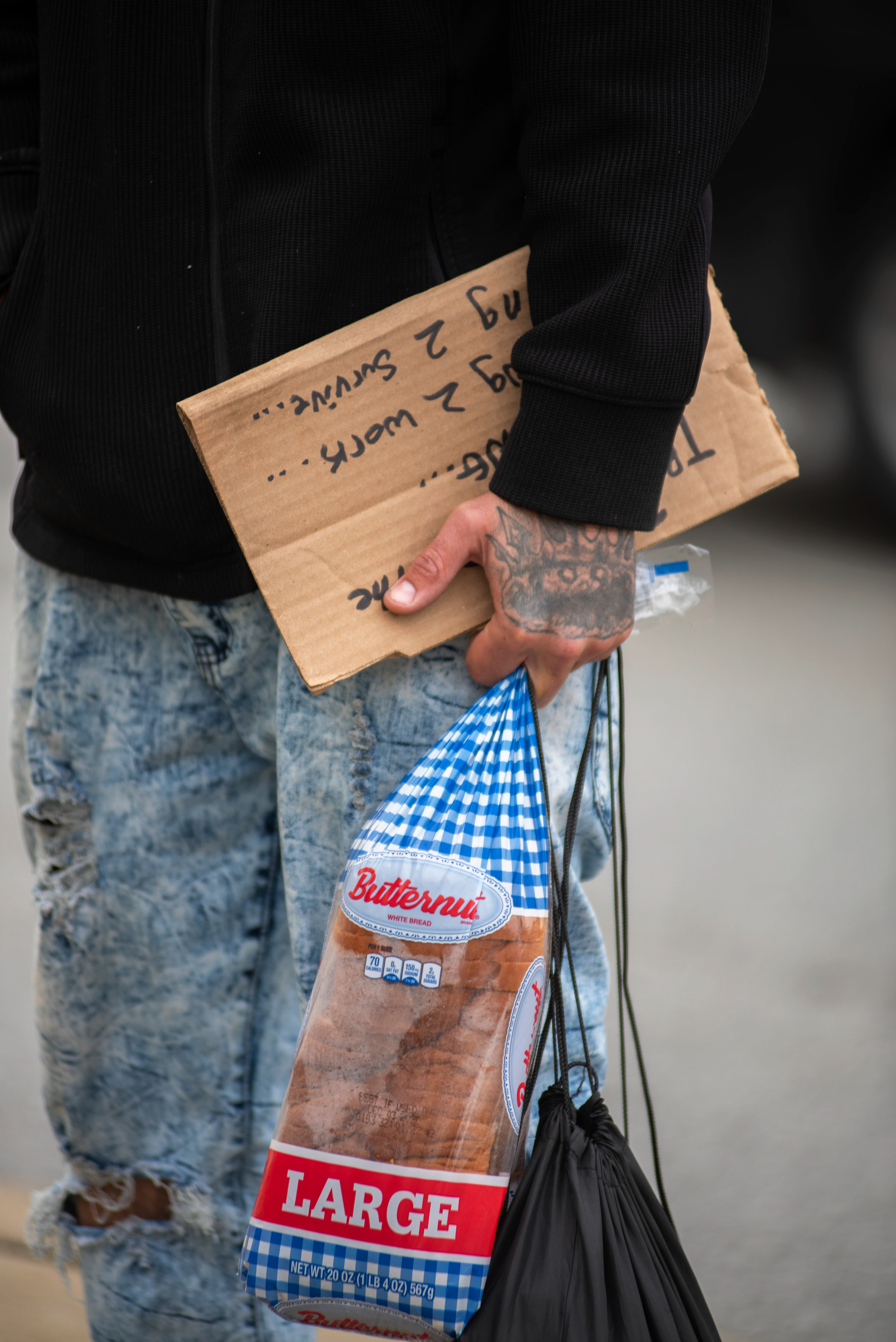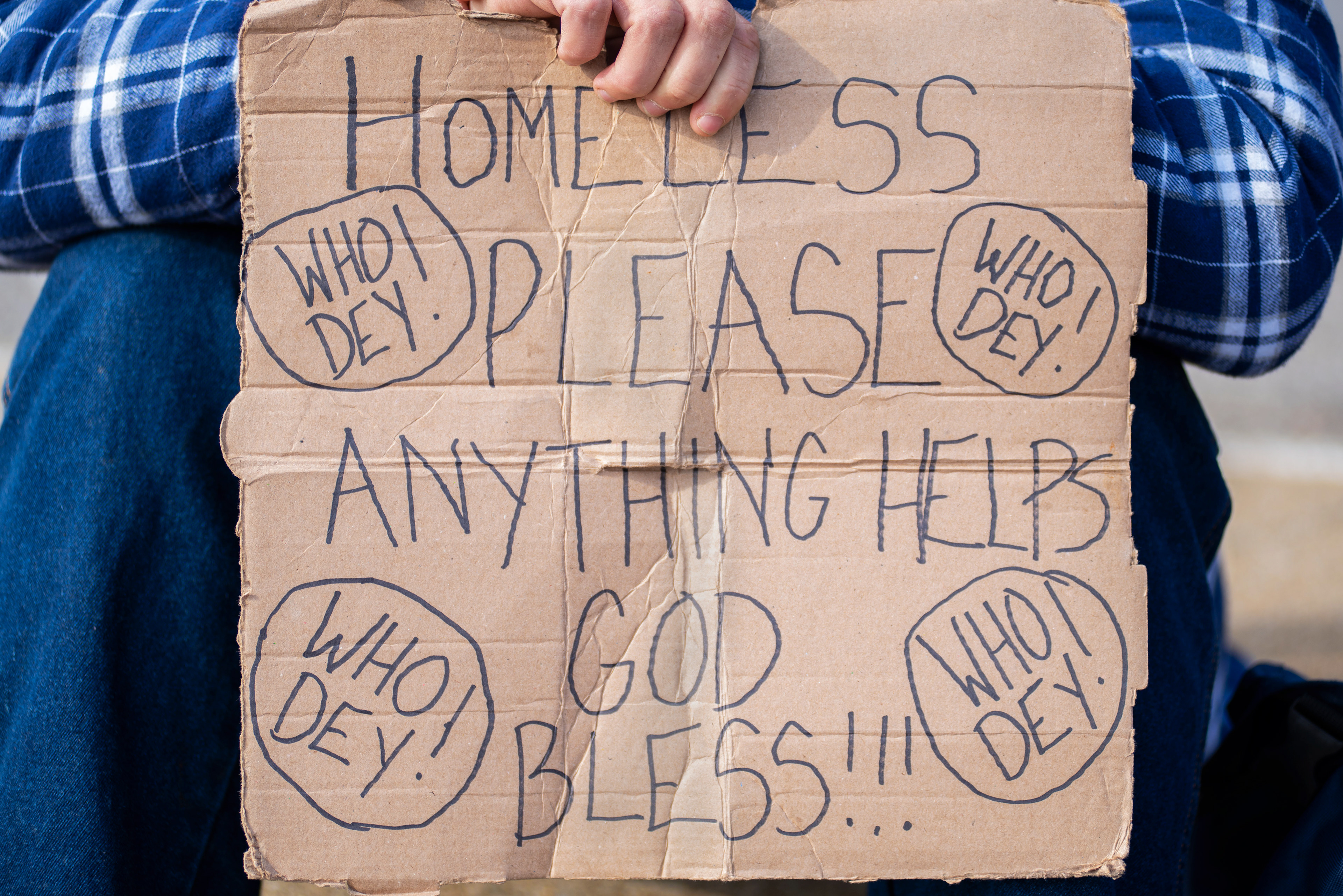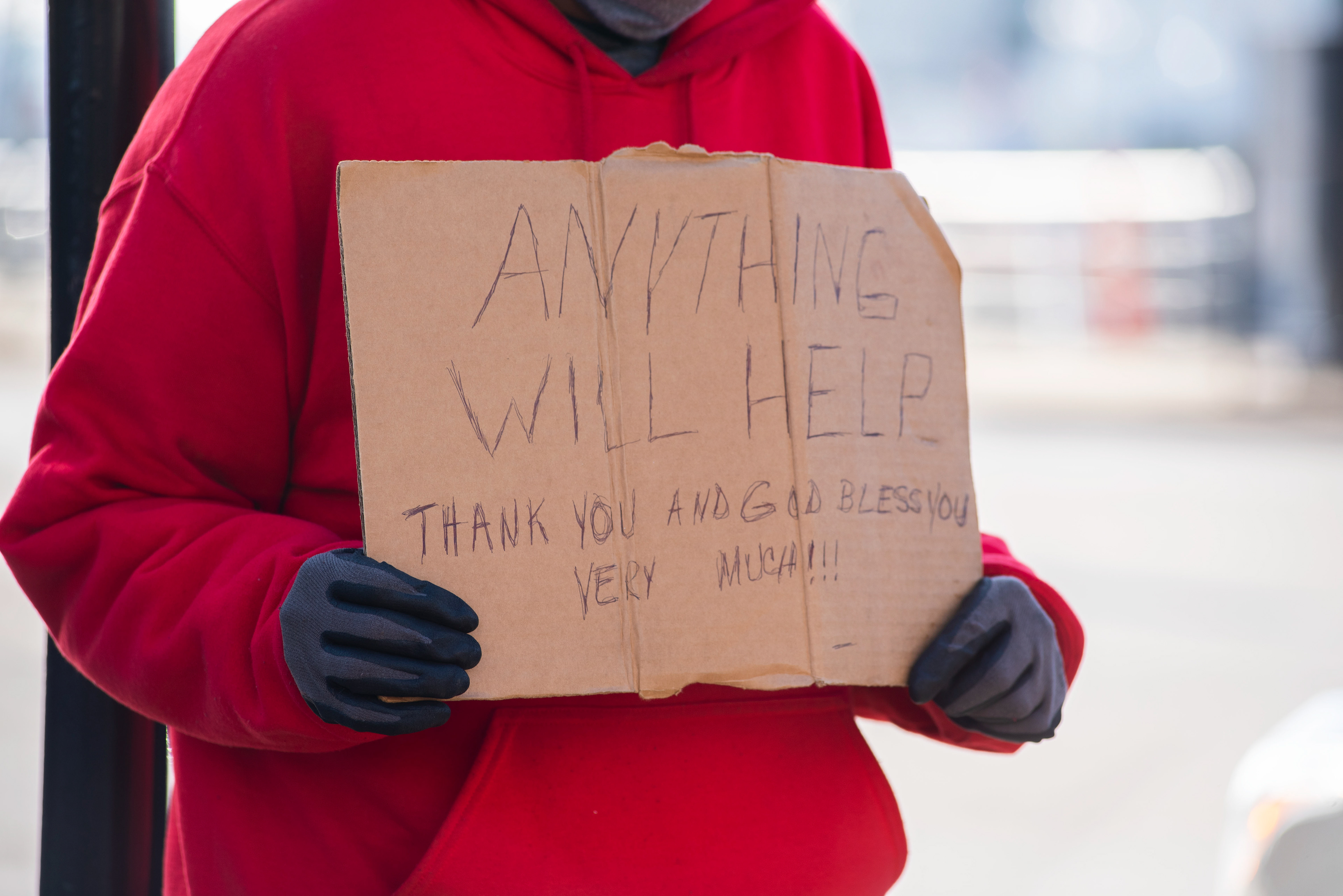Introduction:
Within the first six weeks of the nationwide ‘shutdown’ due to the pandemic, 30 million people lost their jobs according to the Federal government. This was due to the economic downturn that followed people being confined to their homes. An economic downturn and national emergency are two factors which always lead to an increase in homelessness.
The homeless are one of the most vulnerable groups of people to the Coronavirus due to their lack of access to sanitary items, and their poor living conditions. This project is based in Cincinnati, Ohio, where I have been living during the pandemic. The images and stories were all gathered in November and December of 2020.
In Hamilton County, we usually experience what’s referred to as a “Summer Surge” where there is an increase in homelessness once school is out and the family/friends they were staying with kick them out. This year, however, the spike began in March when classes were moved online.
In Hamilton County, we usually experience what’s referred to as a “Summer Surge” where there is an increase in homelessness once school is out and the family/friends they were staying with kick them out. This year, however, the spike began in March when classes were moved online.
Evictions being on the rise is another factor contributing to the increased number of displaced people. The state of Ohio chose not to put a moratorium on residential evictions during the pandemic, this means landlords were allowed to continue to evict tenants. This has led to an increase in “self-help evictions” in which the landlord changes the locks and turns off the utilities to force residents out.
I was drawn to this subject after seeing a larger number of people on the streets than normal. I was seeing the same faces on the same corners while driving too and from work, and it had a big effect on me emotionally. As always, I noticed a larger number of men on the street than women, and the few women I did approach were not willing to speak to me or get their photo taken. For that reason, there is an all male perspective in this essay.
Methods:
In this essay, I discuss my findings after speaking with six homeless individuals, recording my discussions with them, and doing more research from home. When speaking with each individual, I asked the question, “how has the pandemic affected your quality of life?”. From there, I asked more specific, personalized questions about each of their situations.
I approached it with a Humans of New York feel. I took portraits of each individual that I spoke to and then used my audio recordings from the conversations I had with them to type up a synopsis of their stories. I also chose to pair each portrait with a detail shot taken of them.
I began by driving to the spots where I regularly saw the same individuals, and then continued into the inner city, which is where the most concentrated number of homeless live. This area is downtown Cincinnati, which has become increasingly gentrified in the last few years. Most of the homeless shelters, and other resources, are also located in the downtown area.
Chris Hayes


Hayes was released from prison in April 2020 due to the Pandemic and has been homeless since. “I don’t have an ID or a birth certificate, you have to go in places to get it, it’s all closed up. You have to have all of that to get a job,” he says. Hayes expressed his frustration for the situation that he finds himself stuck in that is beyond his control. His story is much like that of others.
At the start of the pandemic, Hamilton County Sheriff Jim Neal was authorized by the court to release low-risk, non-violent inmates (this excludes sex crimes) from jail. Although not all non- violent offenders were released, 500 motions were filed to have inmates released in hopes to lower the population of people locked up and decrease the spread of the virus. This did little to nothing to lower these rates, which are now higher than at the start of the pandemic, and inmates who were released were given nothing to help them get back on their feet. “They let me out of jail and I got two shots of Narcan, that’s all I got,” Hayes told me.
Other newly released individuals are facing similar situations. Some are able to stay on family/ friends couches for a period of time, but with no job, and no way to get an ID after their release, they end up on the streets. Hayes also made note of the fact that he has no way of washing up because most places who would previously open up their restrooms to the public, have closed them down during this time. This adds to their level of risk, because good hygiene is imperative during an outbreak.
Larry Greeves


Greeves says the pandemic has hurt him bad because no one will give him money. “I’ve been out here since six o’clock this morning, I’ve made seven dollars. I usually make a hundred dollars a day,” he says. When asking for his permission to interview and take a few photos, he asked me how much they were worth. I noticed throughout my conversation with him that money was of more importance than even food, water, or immediate shelter (he told me he knew nothing about the shelters and that he lives under a bridge). This led me to think maybe he wants the money for drugs, however I cannot substantiate such claims.
His sign reads, “Homeless vet. Please help. God bless. My friend died, he passed away standing right [here], was too ugly to be a hooker. God bless. Thank you”. Greeves is a very familiar face for me, because he camps out down the street from my job at the Reading Road Graeter’s. I was informed by a colleague that his friend, as mentioned, died a week prior to me speaking with him. It is unclear what caused his death. Greeves’ friend had a girlfriend that would also camp out with them in that same intersection, her location is now unknown. I was also informed that around that same time, Greeves was in a comma after being found lying in the woods and taken to the hospital. This also made me concerned about possible drug use being a factor in not only his health, but his deceased friend’s.
Dustin West


When asked about the pandemic, West says, “It’s been horrible, I can’t get any work anywhere, the work that I did have, I lost my hours, so ultimately lost my job. Now I’m out here trying to hold a sign and panhandle because I can’t get enough work to help support my family”. West and his family are currently facing eviction.
West shares in his struggle to get work and provide for a family with many others. A lot of American’s are currently facing the threat of homelessness due to threats of eviction. Because of this, the rates we see now, are only going to increase as people continue to dig deeper and deeper into debt the longer they are without jobs.
I noticed a sense of shame for what he was having to do. He was not proud about the fact that his struggles led him to asking for money on the streets, but this is what he has had to resort to.
Buster Harden


Harden’s situation is very similar to West’s. He is not currently homeless, but on the streets twice a week trying to make money so that he can avoid homelessness. He is also facing an eviction and is extremely upset about the landlords still having this power during a time of crisis.
Harden had some pretty controversial takes on the virus, saying, “I believe they already have a cure, they’re just taking their time passing it out. It may not work for everybody, but I think it will work for those who are strong enough to handle it.” He went further on to say, “I don’t know what this world is coming to. If it wasn’t the Vietnam War, it’s this now. I still think they’re trying to kill off people to keep the population down. I may be wrong for saying that, but that’s how I feel about that. I knew it was the war in my time, now it’s diseases.”
He has had several cousins as well as friends who have caught the virus, some of who even had to be put on ventilators. This makes him nervous because he is in the older age range that is more susceptible to the virus, and his girlfriend has COPD causing her to be at higher risk as well.
Roger Herthel


Herthel finds himself homeless after his father, with whom he was staying while he’s unemployed, passed away. “It’s been harder to get an ID to get work right now. I’ve been waiting for the BMV to open back up so I can go to the job center,” he says. This seems to be a constant theme with the people I spoke with. Their lack of access to the resources they need in order to get a job is severely holding them back, and completely out of their control. Another issue with this is that you have to have an Ohio residency to be issued an Ohio ID, which many of these individuals do not have. Herthel is originally from Kentucky, and wasn’t having any luck there either.
I asked if Herthel had been in contact with any of the shelters, he told me, “Sometimes the people come around and talk to us, but it seems like every time I come back to where they are, I miss them,”. The shelters located around Cincinnati are almost always full, and it seems to be hard for individuals to get in contact with them. Some people, like this next individual, tend to avoid shelters all together.
Dwane Fisher


Fisher says the pandemic hasn’t really had much of an effect on him. “I’ve been out here four years so, I’ve been through a lot of other things, the pandemic is just one of them. All in all, I’ve gone though some struggles but, I’ve stayed healthy all my life,”. I was struck by what a caring, soulful person he came across as. He seemed to have a joy inside him and I couldn’t figure out how someone who has lived with so little for so long, could still have that kind of attitude.
Fisher did admit that money has been a hit or miss since March, but he didn’t seem to really complain. Like any other time, he says, there are people who give and people who don’t. “I just take it one day at a time. I get it on most days, but I don’t get it on somedays. It’s been like that since March, but it’s been alright,” he told me.
I also asked Fisher if he had tried to get in contact with any of the shelters, to which he replied, “I will not go to a shelter, I’m sorry. They don’t treat you like you’re a person in the shelter, I would rather be out here freezing my tuchus off before I go to the shelter,”. I have heard this from people before, about certain shelters being dehumanizing, but it was heartbreaking to hear. The systems we have in place to help these people should be doing a better job, no matter how large their numbers are.
Conclusion:
During the start of the pandemic, almost 40% of Americans with a salary under $40,000 lost their jobs, according to the Federal government. We have yet to see the full repercussions from this, as people continue to lose more jobs and more and more people are kicked out of their temporary places of residency, or become bankrupt. Strategies to End Homelessness says,“Normally it takes a year or more for someone who hasn’t otherwise gotten back on their feet and into housing to find themselves on the street or entering a shelter”. Losing jobs is just the first step, we are still experiencing a waiting period and these numbers will continue to rise into next year.
The systems we have in place now for those who are homeless, in shelters, or just released from jail, are not working during the pandemic. We need to take a harder look at those who are the most vulnerable at this time, and come together to find solutions to get them back on their feet. Because, if they do well, we do well as a community, a nation, and globally.
References:
• Cincinnati Enquirer: https://www.cincinnati.com/story/news/2020/10/23/were-nonviolent- offenders-released-hamilton-county-justice-center-due-pandemic/3741844001/
• Humans of New York by Brandon Stanton
• Strategies To End Homelessness: strategiestoendhomelessness.org